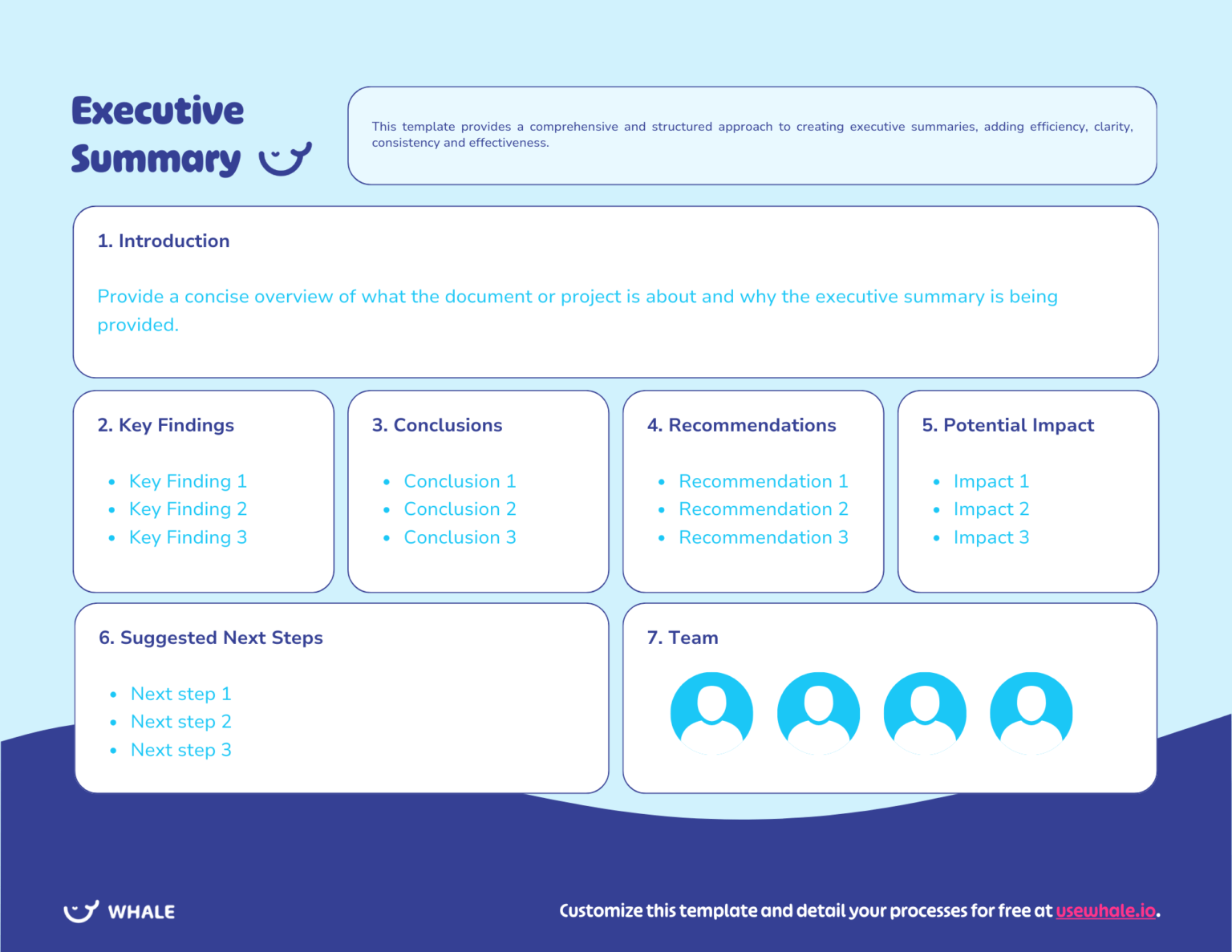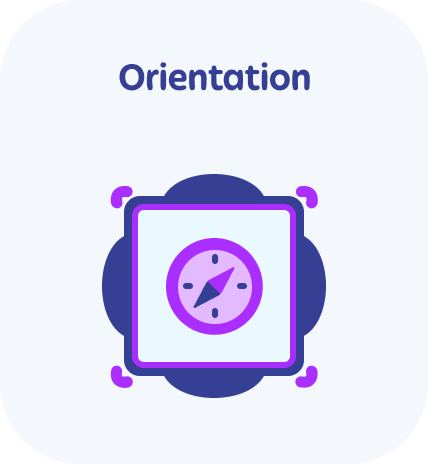An executive summary is exactly that; it’s a concise presentation of the fundamentals of a larger report.
It’s the ultimate tool in getting other’s to buy into your strategic vision.
In this template, we will guide you through crafting the perfect executive summary. Whether pitching to investors or participating in competitive tenders, a well-constructed executive summary can set you apart from the crowd.
What is an Executive Summary?
An executive summary succinctly outlines your business plan or project proposal, providing a snapshot.
Think of it as an elevator pitch on paper — it highlights what problem you solve, why it matters, how you plan to succeed and what you need from the reader.
An executive summary is the cornerstone of any strategic business document, designed to capture and convey the essence of a business plan or project within a condensed format.
Typically limited to one page, it summarizes the most critical aspects of a larger report or business plan. This section of a business plan, report, or proposal acts as a standalone mini-document that outlines your business’s purpose, strategy, and potential.
Key Components of an Executive Summary
- Purpose
- Problem statement or market need
- Solution offered and /or future vision
- The ask of the reader
What are the Benefits of an Executive Summary?
An executive summary offers multiple strategic advantages that can significantly impact the success of a business document. Here’s how a well-crafted executive summary can make a difference:
Clarity and Focus
An executive summary forces you to distill long reports to its essentials, enhancing clarity and focus. This concise overview allows readers to quickly grasp the core idea and the strategic intent behind your business.
Time Efficiency
Time is a valuable commodity in the business world. An executive summary saves time for busy stakeholders, investors, and executives by allowing them to understand the business without having to delve into the full document. This can be particularly crucial in decision-making contexts where time constraints are a factor.
Enhanced First Impressions
First impressions matter, especially when you are seeking investment or approval. A compelling executive summary can intrigue a reader enough to engage them deeply with the rest of your business plan or proposal. It’s your first (and sometimes only) opportunity to grab their attention and make a strong impression.
Facilitates Decision Making
By presenting all critical information upfront, an executive summary aids in faster and more informed decision-making. Stakeholders can assess the viability and potential of a proposal without wading through detailed reports, making it easier to reach conclusions and take action.
Erin Lebacqz on writing an executive summary
Use our templates to fast-track your documentation
Customize this template and 100s of others for free in Whale, the fastest way to get your team aligned.
Consequences of a badly written executive summary
Time is money.
A poorly written executive summary doesn’t just undermine the document’s effectiveness. It results in;
- Lost opportunities for funding
- Lack of clarity
- Wasted time
- Ineffective decision making
- And even poor brand image
It isn’t difficult to get an executive summary right, but you definitely don’t want to get it wrong.
✅ Your executive summary checklist
Before you start writing your executive summary, make sure you keep this checklist handy.
- Know your audience: Do you know what your audience wants?
- Use clear, simple and professional language that your reader will understand. NB! This is not a time for storytelling.
- Create prominent headings and format your document correctly E.g. same font, spacing etc.
- Highlight key points and present them in a clear and concise manner so they make sense to the reader.
- Edit and proofread – nothing turns off a reader more than a Type-O.
The 4 parts of an executive summary
Research indicates that decision-makers spend as little as 30 seconds scanning an executive summary before deciding whether to read further or discard a proposal.
This highlights the importance of clarity and conciseness in your executive summary.
❌ Get in wrong, and you’re out in as little as 30 seconds!
So, while the elements below may seem like a lot, it’s important to condense all the relevant information into one concise document.
A well-structured executive summary is pivotal for achieving the desired impact on its readers. To ensure completeness and effectiveness, it typically includes the following elements:
1. Highlighting the problem
What exactly are you trying to achieve with your executive summary?
You need to highlight the problem you’re trying to solve to your reader; clearly and quickly.
Tip: Be very clear about the business need The focus here is the reader and their pain point, not you or your company!
2. Outlining the solution
How do you propose to solve the problem you highlighted in point 1?
What revolutionary solution or groundbreaking idea do you propose?
Tip: Give the reader something to be excited about.
3. Outlining the value
What is your unique value proposition? Investors won’t invest in just any business.
Tip: Okay, NOW it’s time to talk about you. What value are you bringing to the table? Talk about your strengths, but never lie.
The Ask 🤝
Here it’s time to ask for what you need. Clearly articulate what is being sought from the reader of your summary, be it investment, partnership, or other forms of support.
Don’t forget to include the projected outcomes: What the stakeholders can expect in return, emphasizing potential returns on investment and other benefits.
5 Types of executive summaries
Executive summaries serve a multitude of purposes across various business activities. Their flexibility and concise nature make them essential tools in several contexts.
Here are different types of executive summaries and their use cases.
1. Business plan executive summary
You’re going to need a business plan when you start a business. It’ll help guide you on how to structure your business. But also banks and investors will require a business plan when you ask for an investment or loan.
The business plan executive summary highlights the business mission and vision, market analysis, products/services, financial projections, and growth strategies.
2. Investor pitch executive summary
When seeking funding, an executive summary can be the deciding factor in whether an investor decides to read your full business plan or meet for a pitch.
An investor pitch executive summary captures the essence of the business and the financial promise succinctly to spark interest.
3. Donor funding or grant application executive summary
For non-profit organizations or research projects, an executive summary is crucial to outline the project’s scope, objectives, and the significance of the potential impact, persuading funders of the value and feasibility of the project.
A grant application executive summary should highlight the reason for offering funding to a specific cause.
4. Partnership proposal executive summary
When proposing a partnership, an executive summary can serve to quickly align potential partners with your business’s goals, strategic fits, and mutual benefits, setting the stage for more detailed discussions.
A partnership proposal executive summary will entice the right partners to get involved in your business.
5. Internal report executive summary
In large corporations, executive summaries can help communicate the contents of lengthy reports or project updates to senior management, enabling them to quickly grasp the essential information without needing to review all details.
Consider an annual report and just how much an executive summary can enhance it’s message to staff, and investors alike.
Common Pitfalls in Executive Summary Writing
Let’s face it, crafting an executive summary might seem like a walk in the park until you actually sit down to write one. Suddenly, you’re faced with a plethora of pitfalls that can turn your concise masterpiece into a misunderstood mess. To ensure you hit the mark, here’s a rundown of the usual suspects that can derail your executive summary and how you can gracefully sidestep them:
- Using jargon, acronyms, or technical terms: The executive summary isn’t the place to flaunt your industry lingo. Its purpose is to be the bridge that connects you with a broader audience, many of whom might not be fluent in your professional dialect. So, ditch the jargon and opt for simplicity and clarity. Think of it as explaining your project to a friend who’s curious yet uninitiated into your field.
- Being too long or too short: This is where Goldilocks comes in – your summary has to be just right. Aiming for 10% of your document’s length is a good starting point, typically landing you between one to two pages. But, as with any rule, you need to feel the room. Depending on what you’re summarizing, adjust accordingly without sacrificing the essence or bogging down readers with unnecessary detail.
- Being vague or general: “Some people did something somewhere” isn’t going to cut it. Your summary needs meat – specifics that showcase the who, what, when, where, and why in a way that’s as compelling as your full document. Drop quantifiable facts, noteworthy stats, and real-world examples to transform your summary from blah to brilliant.
- Being inconsistent or contradictory: Your executive summary is the appetizer to the main course that is your complete document. It should set the stage, not confuse the audience. Ensure that your tone, terminology, and takeaways mirror those in the larger document, offering a seamless transition from summary to full analysis.
Example of an executive summary
In its early years, Apple’s executive summary for its Macintosh project helped secure crucial funding and partnerships by succinctly outlining the innovative features of the Mac and its potential to disrupt the computing industry.
This summary was instrumental in communicating the revolutionary aspects of the product to investors who may not have had deep technical knowledge.
FAQs on an exectuve summary
How long should an executive summary be?
Ever heard the saying, ‘less is more’? Well, it applies here. An executive summary is your elevator pitch – it needs to be quick but comprehensive. Typically, we’re talking about a cozy one to four pages max, or less than 10% of the longer document it’s summarizing. It’s about capturing the essence, not rewriting the full script.
What are the 4 elements of an executive summary?
Here are the universal must-haves, no matter where your summary lands:
- The problem or opportunity: Picture this – you’re setting the stage with the issue at hand or the goldmine you’ve stumbled upon. Why should your audience sit up and take notice? Because you’re about to show them why it matters, and why the time to act is now.
- The solution or recommendation: Here’s the climax of your story. You’ve laid out the problem, and now you’re unveiling your master plan, your proposition that’s set to change the game. What sets your solution apart from the rest? This is your moment to shine and show how you outpace any competition.
- The benefits or outcomes: Time to bring the proof to the pudding. What’s in it for your audience? How does your solution transform the landscape? Back it up with solid evidence or data, and paint a picture of success that aligns with your audience’s ambitions and goals.
- The call to action: And now, the finale. You’ve got their attention, shown them the path to glory – now what? This is where you guide them towards the next steps, be it green-lighting your proposal, funding your dream, or setting your plan in motion. Leave nothing to ambiguity; give them the map to find you for more deets.
Use our templates to fast-track your documentation
Customize this template and 100s of others for free in Whale, the fastest way to get your team aligned.







